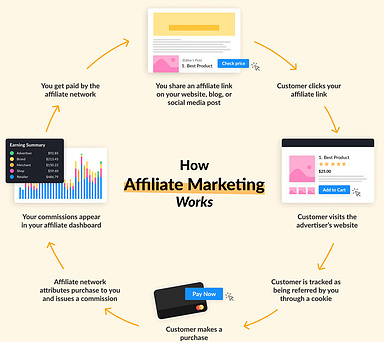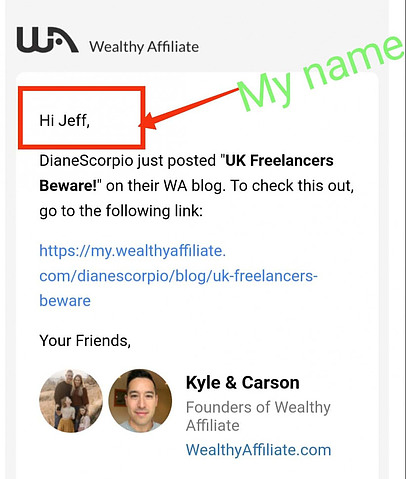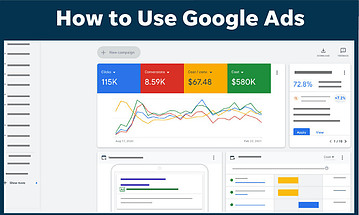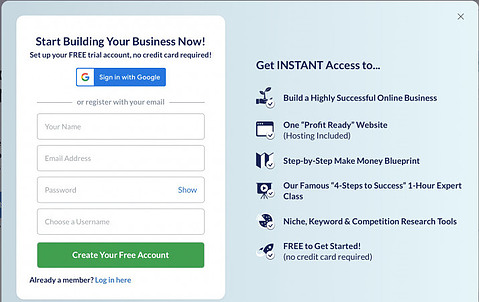In affiliate marketing, affiliate links are a type of URL that contains a unique tracking code. These links are used in affiliate marketing programs to track and attribute sales or other desired actions generated by the affiliate marketer.
Affiliate links often look like standard URLs but include the unique tracking parameters. For example, a standard link for Wealthy Affiliate looks like this:
https://www.wealthyaffiliate.com
An affiliate link for an affiliate for this program for the same product might look like:
https://www.wealthyaffiliate.com/?a_aid=5e7c887d
The /?a_aid=5e7c887d part of the URL is the tracking parameter, which allows the affiliate program to credit the sale or
action to the specific affiliate with the ID ‘5e7c887d‘. This helps track and reward affiliates for their marketing efforts.
How Does Affiliate Link Work?
Affiliate marketing is a performance-based marketing strategy, meaning that affiliates are compensated based on their ability to drive sales or other conversions. It is a common way for companies to expand their reach and increase sales because affiliates have a financial incentive to promote their products or services effectively.
This is how affiliate links plugs in into the online marketing chain:

- Unique Tracking Code: Each affiliate marketer is provided with a unique tracking code or affiliate ID. This code is embedded within the affiliate link.
- Promotion: The affiliate marketer promotes products or services from a company or merchant, typically through their website, blog, social media, email marketing, or other online channels.
- Click and Conversion Tracking: When a user clicks on an affiliate link and is redirected to the merchant’s website, the tracking code in the URL identifies that the click came from a specific affiliate.
- Credit: If the user performs a specific action on the merchant’s website, such as making a purchase, signing up for a service, or filling out a form, the affiliate program’s tracking system attributes that action to the referring affiliate.
- Commissions: Affiliates earn a commission or a predetermined payment for each successful referral or action attributed to them through their affiliate link. The commission structure varies based on the affiliate program and the type of product or service being promoted.
Why Do You Need to Promote Your Affiliate Links?
Promoting your affiliate links is essential for several reasons if you want to succeed as an affiliate marketer. Here’s why promoting your affiliate links is important:
- Earning Commissions – The primary goal of affiliate marketing is to make money through commissions. When people use your affiliate links to make a purchase, you earn a percentage of the sale. Promoting your links increases the chances of conversions, leading to higher earnings.
- Increased Visibility – By actively promoting your affiliate links, you can increase the visibility of the products or services you’re promoting. This can lead to more people discovering the product, which can result in more sales.
- Relevance – Promoting your affiliate links allows you to target a specific audience or niche. By sharing the links with people who are genuinely interested in the products or services, you can increase the likelihood of conversions.
- Trust and Credibility – Promoting your affiliate links also involves building trust and credibility with your audience. When you provide valuable information and recommend products or services that genuinely benefit your audience, they are more likely to trust your recommendations and make a purchase through your links.
- Differentiation – Affiliate marketing is a competitive field. Promoting your links effectively allows you to stand out from other affiliates who may be promoting the same products or services. You can differentiate yourself through your content, unique selling propositions, and marketing strategies.
- Analytics and Optimization – By actively promoting your links, you can gather data and analytics about the performance of your campaigns. This data can help you understand what works and what doesn’t, allowing you to optimize your strategies for better results.
- Compliance – Depending on the affiliate program, there may be requirements for active promotion. Some programs have terms and conditions that affiliates must meet to remain in good standing. Failing to promote your affiliate links could lead to account suspension or termination.
- Long-term Success – Building a successful affiliate marketing business requires consistent effort. Regularly promoting your affiliate links is part of that effort and can contribute to your long-term success in the field.
Notwithstanding, it’s crucial to promote your affiliate links ethically and in a way that genuinely benefits your audience to maintain trust and credibility for the long haul.
Methods of Promoting Affiliate Links
Promoting your affiliate links effectively involves a combination of strategies and tactics. Its also important to temember that successful affiliate marketing takes time and effort. Before you embark on your promotion efforts, ensure the following foundational activities;
- Choice of Right Affiliate Program/Network – Choose affiliate programs that align with your niche or the interests of your target audience. The affiliate program/network should have transparent link management tools to keep track of your affiliate links. These tools can help in links cloaking, tracking the performance of your links and monitoring the links to ensure they are still active and redirect to the correct landing pages.
- Understand Your Audience – Know your target audience’s needs, preferences, and pain points. This understanding will help you create content and campaigns that resonate with them.
- High-Quality Content – Develop valuable and engaging content that provide solutions, answer questions, and address the needs of your audience.
- SEO Optimization – Use search engine optimization (SEO) techniques to help your content rank well in search engine results. This will increase organic traffic to your content, increasing the chances of conversions through your affiliate links.
Strategy #1: Embed Affiliate Links to Your Content
Adding your affiliate links to the content youve created is a very effective way to promote the links. Whether its a blogpost, YouTube video or a Podcast, you can gain some mileage epsecially if the content receives a good amount of organic traffic.
Its however important to remember that, successs rate of this strategy is hinged on quality,relevant and fresh content. You readers will only click on your affiliate links if the content youve presented to them is helpful to them.
Bloggers can promote affiliate links in your blog by directly linking them as a backlink, adding in graphics with an outbound affiliate link, or embedding your videos with a promotion for that link. Let your audience know what the benefit of this product is to them, showing how much it’s helped you and how it can help them with a specific problem or challenge they have
As a blogger for example, ensure you create informative, well-researched blog posts that incorporate your affiliate links naturally. Write in-depth guides, tutorials, and product reviews. Optimize your content for search engines by using relevant keywords, meta tags, and high-quality backlinks to increase your content’s visibility in search results
If you producing video content on platforms like YouTube, create product demonstrations, tutorials, and reviews with affiliate links in the video descriptions.
Strategy #2: Email List
Building and maintaining an email list is a valuable component of affiliate marketing and content promotion. An email list allows you to directly reach and engage with your audience, nurturing relationships and driving affiliate conversions.
The online sace is awash with reputable email marketing platform (ESP), such as Aweber, MailerLite, ConvertKit, AWeber, MailChimp to manage your email list. ESPs provide tools for creating and sending emails, managing subscribers and tracking email performance.
part of of this strategy include;
- Opt-In Forms – Include opt-in forms on your website, blog, or landing pages. These forms should collect email addresses and may ask for additional information like name or preferences. Below is an example of Wealthy Affiliate Opt-in form.
- Content Upgrades – Offer content upgrades or lead magnets, such as e-books, checklists, templates, or exclusive guides, in exchange for email sign-ups.
- Exit-Intent Pop-ups – Use exit-intent pop-ups that appear when a user is about to leave your site. These can capture emails from visitors who might otherwise exit without subscribing.
- Webinars and Workshops – Host webinars or online workshops, and require registration with an email address to participate.
- Contests and Giveaways – Run contests or giveaways with email sign-up as an entry requirement.
- Referral Programs – Implement referral programs where subscribers can earn rewards or incentives for referring others to join your list.
Email Segmentation and Personalization
The email list should always take into account the search intent of your target audience. Its therefore imortant to group the list based on factors such as demographics, interests, behavior or purchase history. This allows you to send targeted and personalized content.
It is also imortant to Personalize your emails by addressing subscribers by their names and tailoring the content to their specific needs and preferences. As a member of Wealthy Affiliate Program, i receive Periodic emails addresed to my name as shown below;

Email Content
No need to re-emhasize the role of quality content. Content is the king, eriod!
Ensure you craft compelling and relevant email content that provides value to your subscribers. This may include updates, tips, product recommendations, or exclusive offers.
Use attention-grabbing subject lines to increase open rates.
Include clear CTAs that guide subscribers to take action, such as clicking on your affiliate links (note the affiliate link in the above examPle)
Automate Email Delivery
It is imortant to guarantee your subscribers consistent in informing them of new releases, udates, romtions etc. This calls for setting up email automation sequences to send predefined series of emails. For example, you can create welcome sequences, onboarding sequences, or product recommendation sequences.
Some of your target audience may prefer daily updates, while others might only want a weekly or monthly newsletter. Its therefore imortant to determine the optimal email frequency for your audience.
Theres Automation helps you engage with subscribers at various stages of the customer journey.
Compliance
Ensure your email marketing practices comply with anti-spam laws, such as the CAN-SPAM Act in the United States or GDPR in the European Union. This includes providing an option for subscribers to opt out (unsubscribe) and disclosing your identity in emails (see above examle where the authors of the email aree asily identifiable).
Some programs may have specific guidelines regarding email promotion. Ensure that your email marketing practices comply with the terms and conditions of the affiliate programs you’re part of.
Email List Maintenance
Regularly clean your email list by removing inactive or unengaged subscribers. This helps improve deliverability and maintain a healthy sender reputation.
Try ConvertKit Email Funnels
Strategy #3: Share Affiliate Links in Social Media
Social media is a powerful platform for promoting affiliate links and driving traffic to your affiliate offers. Here’s how you can effectively use social media in your affiliate marketing efforts:
- Choose the Right Platforms – Identify the social media platforms that best suit your niche and target audience.
- Create High-Quality Profiles – Creating engaging posts and adding affiliate links in the caption or bio.
- Content Strategy – Create a mix of content types, including blog posts, videos, images, infographics etc. Your content should educate, entertain, or solve problems. Create a content schedule to maintain consistency in your posting.
- Visuals and Graphics – Visual content tends to perform well on social media. Use eye-catching images, graphics, and videos in your posts.
- Hashtags – Utilize relevant hashtags in your posts to increase the discoverability of your content. Research popular and niche-specific hashtags in your industry.
- Engagement and Interaction – Actively engage with your audience by responding to comments, questions, and messages. Foster a sense of community and build relationships with your followers.
- Storytelling – Use storytelling to connect with your audience. Share your personal experiences with the products or services you’re promoting to make your recommendations more authentic.
- Analytics and Tracking – Use social media analytics tools to track the performance of your posts and campaigns. Analyze engagement metrics and conversion rates to refine your strategies.
- Effective social media promotion of affiliate links involves a balance of providing valuable content and promotion. promotion of affiliate products should be authentic and helpful to your audience. Remember trust and credibility is key to success in affiliate marketing on social media. Learn How to Use Affiliate Links in Social Media
Strategy #4: Paid Advertising
Paid advertising is a powerful strategy to promote your affiliate links and drive targeted traffic to your content or affiliate offers. This can help you reach those that are most likely to purchase your products.
You should always bear in mind that you are spending money to capture the leads. The guiding rule should be to spend less than your targetted aggregated income.
Advertising platforms
Advertising platforms offer a variety of targeting options to help you reach your desired audience effectively. popular advertising platforms include;
- Google Ads
- LinkedIn Ads
- Microsoft Advertising (formerly Bing Ads)
- interest Ads
- Twitter Ads
- YouTube Ads
Google Ads is one of the best opportunities to promote your affiliate links. The fact that its owned by Google can only make it a natural choice for bloggers.
Paid Advertising work by displaying your ad to potential customers who are browsing the internet, using social media or a particular app. When your ad is clicked, the visitor will be redirected to your website or landing page for more details on your product or service.
Paid ads can help you get your affiliate links in front of more people leading to more clicks and conversions. To ensure an effective and optimal reach of your ads, the following steps;
#1. Select the Right Advertising Platform
Advertising platforms have different targeting options that ranges from keywords, demograhic, location, behavioural, skills to even device targeting.
Choose the advertising platforms that align with your target audience and the products or services you’re promoting. For examle LinkedIn is popular with skills targeting.
#2. Keyword Research:
If you’re using pay-per-click (PPC) advertising, conduct thorough keyword research to identify the most relevant and high-converting keywords in your niche. Free tools like Google Keyword Planner or Jaaxy will greatly help you to find keywords with the right balance between search volume and competition.
#3. Ad Creative:
Craft compelling ad copy and visuals that grab the audience’s attention and encourage them to click. Highlight the benefits and unique selling points of the products or services you’re promoting.
Ensure your ad copy is compliant with the advertising platform’s policies and guidelines.
#4. Landing Pages
The landing pages should always be highly relevant to the ad content and provide a clear path to take action (e.g., click your affiliate links or make a purchase). Ensure that you that you’ve design a dedicated landing page for each paid advertising campaign that is optimized for conversion.
#5. Ad Targeting
The core of paid ads is targeting. This is where the latform’s specialization mentioned earlier comes into play. Use retargeting or remarketing to re-engage with users who have previously interacted with your content or affiliate links.
As earleir stated, paid ads involve spending. You must therefore have a budget and monitor it closely to ensure cost effectiveness.
A conversion tracking system should always be in alce to measure the effectiveness of your paid advertising campaigns. This helps you understand which ads and keywords are generating the most conversions. Connecting your conversion tracking with your affiliate links will help in attributing conversions to specific ads.
Summary
Promoting affiliate links is a perfect way increase your earnings online. You can write killer blogposts, slip the links into email lists or even use pay-per-click ads to wider your revenue channels. Dont forget that each of the advertsing platforms has its core cometencies which you should take advantage appropriately. Google Ads is great but dont forget about Pinterest, Bing and LinkedIn – they’re all goldmines for reaching your target audience.
It is important to strike the perfect balance between giving your readers valuable content and throwing around those affiliate links. Finally, always remeber track your affiliate links with free tools like Google Analytics – you cant improve what you dont know
Jeff
Safariiaffiliate

